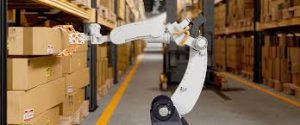Unsure of exactly what warehouse logistics entails? If so, don’t worry – you’re about to find out! Warehouse logistics is the process of organising and managing the flow of goods through a warehouse. This can include everything from receiving and storing products to shipping them to customers. It’s a vital part of supply chain management and plays a key role in ensuring that products are delivered on time and in the right condition. In this article, we will discuss what warehouse logistics is, its benefits, and how you can get started or improve your current systems!
What is Warehouse Logistics?
Warehouse logistics is the process of organising and managing the flow of goods through a warehouse. This can include everything from receiving and storing products to shipping them to customers. It’s a vital part of the supply chain and plays a key role in ensuring that products are delivered on time and in the right condition.

Forklifts play a vital role in warehouse logistics
Find Your Perfect Forklift
Compare Quotes from Local Forklift Dealerships


Enter Requirements


We Find the Best Deal


Receive your Quote
The Benefits And Advantages Of Warehouse Logistics
There are many benefits to implementing warehouse logistics into your business. Perhaps the most obvious benefit is that it can help to improve efficiency and productivity within the warehouse making complex operations easier and less labour intensive. By streamlining the entire process and improving organisation, you can reduce errors and give yourself a competitive advantage by offering better delivery times and better shipping costs to your customers.
Flow Of Information
Another benefit of warehouse logistics is that it can help to improve the flow of information across the company. Having a good system in place can help to ensure that everyone is involved in the process and able to make informed decisions. Communication is a key element of excellent warehouse logistics and great communication can help to avoid fulfilment delays and disruptions in the supply chain and over the long term improve customer satisfaction.
The Benefits On Warehouse Safety
Warehouse logistics can also help to improve safety within the warehouse. By having a well-organised system, you can minimise the risk of accidents and injuries. This can create a safer environment for employees improving employee retention and helping to protect your assets and inventory.
Maximise Warehouse space
Another advantage of warehouse logistics is the effective use of warehouse space. By organising the warehouse and implementing an effective storage system, you can utilise the available space more efficiently which can lead to cost savings due to the amount of inventory you can store.
Measuring Efficiency
Having a warehouse logistics plan will also help you to measure the efficiency of your warehouse operations. This can be done by tracking metrics such as order accuracy, stock levels, shipping costs, and more. By monitoring these metrics, you can identify areas where improvements can be made. This information can then be used to make changes to the system to further improve efficiency and lower associated costs.
Stock Control
Warehouse logistics plans can help massively with stock control. By having a good system in place, you can keep track of the exact location of all stock. You will also be able to clearly see all the products that are in the warehouse buildings. This information can then be used in conjunction with automated systems to reorder stock when necessary and completely avoid out-of-stock situations.
Improved Customer Service
Finally, warehouse logistics can also help to improve customer service. By having a well-organised and efficient system in place, you can easily meet customer demand and provide your customers with accurate information about product availability and delivery times. This can lead to improved customer satisfaction and loyalty over the long term.
The Role Of Forklifts In Warehouse Logistics
Forklifts play a vital role in warehouse logistics. They are used to move heavy products and materials around the warehouse and can be used to load and unload trucks. Forklifts can also be used to stack products on shelves or in racks.
There are many different types of forklifts available on the market today with different intended purposes, The most common types of forklifts found in warehouses are:
Pallet Trucks:
Pallet trucks are normally used to move pallets around the warehouse and lift pallets to low storage areas; they are considered a similar version of a forklift truck due to their smaller size and ease of operation.
Forklift Trucks:
Electric forklift trucks are the most common type of forklift found in warehouses. They are used to move heavy products and materials around the warehouse. Forklifts can be used to load and unload trucks, stack products on shelves or in racks, and much more. Every warehouse needs a great forklift truck!
Reach Trucks:
Reach trucks are a type of forklift that is used to move products and materials around the warehouse. They are specially designed to reach high shelves and racks. Reach trucks are very versatile and can be used in a variety of different ways within the warehouse environment.
Order Pickers:
Order pickers are a type of forklift that is used to pick orders from high shelves and racks. Order pickers are great for warehouse efficiency as you can get the exact product you require no matter its location.
How to Create A Warehouse Logistics Plan
If you’re interested in implementing warehouse logistics into your business, there are a few things you’ll need to do. First, you’ll need to fully assess your current operation, your operational costs, your inventory turnover ratio and your customer expectations and identify areas that could be improved. This will help you to develop a plan of action and set goals for your new system.
Next you will need to assess your warehouse space, your current storage solutions and your entire inventory levels this will help when creating inventory management systems and implementing inventory management software. Having good warehouse processes and a strong warehouse team will help massively with inventory control and limiting inventory loss. So invest in your staff by offering employee recognition incentives and cross training employees.
Then, you’ll need to choose a warehouse management system (WMS). This is software that will help you to automate and manage the various processes within your warehouse. Allowing for less human labour and more cost savings. WMS can have large upfront costs but the implementation of this software will transform your warehouse environment in real time by improving cycle times, supply chain operations and inventory movements.
Finally, you’ll need to implement your new system and train employees on how to use it. This can be a challenge, but this is where having great warehouse managers and brilliant employees helps the most! It’s important to make sure that everyone is on board with the new system and understands how it works. Once it’s up and running, you should start to see the benefits of great warehouse logistics in no time!
What Is Warehouse Automation?

Warehouse automation is the use of technology to automate the various processes within a warehouse. This can include everything from material handling to order picking. Warehouse automation can help to improve efficiency and accuracy within the warehouse, while also reducing labour costs.
Warehouse automation usually requires the use of warehouse management software (WMS). Which as we said above is a type of software that helps to automate and manage the various processes within a warehouse. WMS systems can help to improve efficiency and accuracy within the warehouse, while also reducing labour costs. There are many different types of WMS software available, so be sure to do your research and choose one that will meet your specific needs.
How does Warehouse Automation Work?
The most common type of warehouse automation used in modern warehouses, typically begins with the use of barcodes or RFID tags. These are placed on products as they enter the warehouse and are used to track the product throughout the warehouse. The system then uses this information to generate pick lists for employees.
The products are then stored in specific locations within the warehouse, which is known as storage units. When an order comes in, the system will generate a pick list for the employees that includes the location of each product that needs to be picked. The employees then go to the storage units and pick up the products from there.
Once all of the products have been picked, they are brought to a packing station where they are packed into boxes or bags according to the customer’s specifications.
This type of warehouse automation saves countless hours of hunting for stock, and allows for a very efficient process.
Conclusion
We hope this article has given you a better understanding of what warehouse logistics is and how it can benefit your business. If you’re interested in implementing warehouse logistics into your operation, be sure to follow the steps outlined above. With a little planning and effort, you can soon have a well-organised warehouse that’s really efficient and this will improve your bottom line. Thanks for reading!